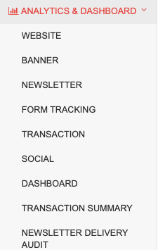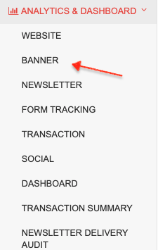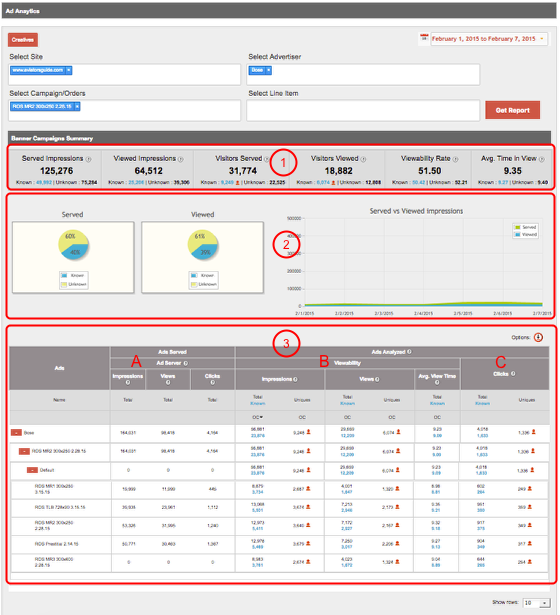Analytics - Running Ad Analytics
The Analytics module consists of Website Analytics, Newsletter Analytics, and Banner/Ad Analytics and provides key analytics and insight into subscriber behavior across your online properties.
The Banner Analytics feature enables you to save, view, or download detailed known and unknown impression statistics for advertisers and individual banners within a specified date range.
Note that for ONECount to track banner impressions with viewability, OpenX admin has to add ONECount Javascript to OpenX zone. See OpenX Zone Setup documentation for more detail.
The following lesson will provide instruction on using Banner Analytics to generate counts/lists.
OPEN THE BANNER ANALYTICS WINDOW
Select ANALYTICS & DASHBOARD from the main menu.

Select Banner from the sub-menu.

This will bring you to the Banner Analytics main window. (See below.)
DEFINITIONS
Advertiser - Advertiser(s) pulled from your ad serving platform. (ONEcount currently supports OpenX/Revive and DFP Premium/DFP Small Business.)
Campaign - Banner campaigns pulled from your ad serving platform. (ONEcount currently supports OpenX/Revive and DFP Premium/DFP Small Business.)
Known -* A user who is in the ONEcount system and has been authenticated and identified.
Unknown = Includes counts of those users who are not authenticated/have not been identified by the ONEcount system. A user may be in your database but be an unkown if they haven't been authenticated by logging in, clicking on a smartlink in an email, or completing a subscription/registration form for a new product.
Total - Total of both Known and Unknown users.
Served Impressions - Number of ads that have been served, whether in view or not when the web page is loaded. This number is calculated by ONEcount.
Viewed Impressions - Number of "viewable" ads that have been served. This number is calculated by ONEcount.
Per the IAB standards on viewability, an ad is counted as "viewed" when the following criteria are met:
- Pixel Requirement: Greater than or equal to 50% of the pixels in the advertisement are on an in-focus browser tab on the viewable space* of the browser page, and
- Time Requirement: The time the pixel requirement is met is greater than or equal to one continuous second, post ad render.
*Viewable space, per IAB is: Advertisements and content associated with each page load can appear either within or outside the viewable space of the browser on a user's screen - i.e., that part of the page within the browser that a user can see. This is similar to the concepts once referred to as "above the fold" (i.e., within the viewable browser space) and "below the fold" (i.e. outside the viewable browser space).
Visitors Served - The number of known visitors who were served ads, viewable or not viewable per IAB standards. If a visitor is served multiple ads, it is counted as one visitor served.
Visitors Viewed - The number of known visitors who were served ads that meet the IAB standards on viewability. If a visitor is served multiple Viewable ads, it is counted as one visitor served.
Ads Served - The total number of ads served. This number is pulled directly from your ad serving platform. (ONEcount currently supports OpenX/Revive ad serving platform.)
Clicks - The number of ads that were clicked on.
Viewability Rate - Number of Viewed Impressions / number of Served Impressions.
**
Avg. Time in View (in seconds) - The average time ads are in view. Calculated by number of seconds in view / number of Viewed Impressions.
- A user must be authenticated and identified by ONEcount to be counted as a Known user. There are different ways to be identified: 1) By logging into a web site (direct log-in or via a lookup form), 2) by clicking on a smartlink** in an email blast, 3) by completing a registration/subscription form for a product. Once authenticated and identified, a cookie will be set, allowing you to track a user's activities as a Known user. If a user is not logged in/identified, activities will be tracked as an Unknown user. Once the user is authenticated and identified, all of his/her activities (including past activities) will be moved from Unknown statistics to Known statistics.*
IMPORTANT NOTE:
In order to identify users and track activity, widgets must be embedded on every page of your web site (placing them in the top-level template will accomplish this). These widgets, specific to your site(s), and directions for placement are provided in the Widget Builder. Please see Widget Builder documentation for moreinformation.
ONEcount Library/Tracker: This javascript snippet controls gating/access, cookie setting and does web tracking.
_Automation Widget: Automation scripts are snippets of javascript code that allow ONEcount to target actions (like ad target, popup target etc). This piece of javascript determines and outputs any automated action to the browser. _
_Noscript Tag: A noscript tag is needed to track requests when js is disabled. _
_Banner Trackers: Banner widgets are used to track and report banner activity. There are two banner platforms supported within ONEcount: OpenX and DFP (Premium and Small Business). _
_ Third Party Trackers Modifications: Usually websites will have third party trackers like Google Analytics, etc. installed on their website. A small piece of code needs to be added to those third party trackers so that ONEcount can pass the original referrer to those systems. We provide the code that needs to be added to your Google analytics code. If any other third party trackers are being used on your website, please let your ONEcount account manager know ahead of time. _
_ONEcount Pixel for Moat: ONEcount can collect ad viewability data from Moat's realtime pixel. In order to send data to ONEcount, Moat can fire a pixel like below to send data to ONEcount. _
A user must be authenticated and identified by ONEcount to be counted as a Known user. There are different ways to be identified: 1) by logging into a web site (direct log-in or via a lookup form), 2) by clicking on a smartlink* in an email blast, 3) by completing a registration/ subscription form for a product. Once authenticated and identified, a cookie will be set, allowing activities to be tracked as a Known user. If a user is not logged in/identified, activities will be tracked as an Unknown user. Once the user is authenticated and identified, his/her activities will be moved from Unknown statistics to Known statistics.
FUNCTIONALITY
Select site, advertiser, campaign/order, and line item (DFP only) and set date range.

See Key Concepts - Ad Analtyics for more detail on how to make selections.
Click "Get Report" button
This will load the analytics report on the page. (See example below.)

The Summary Report displays in three main sections:
1) Aggregate data for all selected advertisers and campaigns
2) Charts/graphical representation of key data
3) Breakdown and detail of aggregate data
The Summary Report breaks out applicable metrics by Known, Total, and Uniques.
For each advertiser, summary data provides:
- analytics on Ads Served, pulled from your ad server,
- ONEcount Viewability data, including Impressions, Views, Avg. View Time,
- ONEcount Click Data
- MOAT viewability data (only if you use MOAT and the ONEcount pixel has been implemented on MOAT)*
See a definitions for each metric under DEFINITIONS section above.
- See below for screenshots of Analytics detail with no MOAT data and with MOAT data.
Ad Analytics Detail – No MOAT Data

Ad Analytics Detail – MOAT Data

Notice the "MOAT" column in the Impressions, Views, and Avg. View Time columns. The MOAT column will only appear and populate if you are using MOAT and ONEcount has been configured to display the MOAT data.
If you do not use MOAT and/or your ONEcount system isn't configured to pull MOAT data in, you won't see a "MOAT" column. (see previous screenshot)
Clicking on the + icon beside the advertiser name will expand to show campaigns/orders, line items, and individual creatives for each selected banner campaign.
For DFP, the hierarchy is Advertiser, Campaign/Order, Line Item, Creative.
For OpenX/Revive, the hierarchy is Advertiser, Campaign/Order, Creative.
Because there are only 3 levels to this hierarchy (OpenX/Revive doesn't haveLine Item), the word "Default" will appear instead of the Line Item name. (See screenshot below.)
Search all Documentation:
Unknown macro: livesearch. Click on this message for details.
The [livesearch] macro is not in the list of registered macros. Verify the spelling or contact your administrator.
Search ANALYTICS Documentation:
Unknown macro: pagetreesearch. Click on this message for details.
The [pagetreesearch] macro is not in the list of registered macros. Verify the spelling or contact your administrator.
On this page:
More ANALYTICS Documentation:
Click here to expand...
Web Analytics
Ad Analytics
Email/Newsletter Analytics
Key Concepts - Email/Newsletter Analytics
Running Email/Newsletter Analytics
Form Tracking Analytics
Running Form Tracking Analytics
